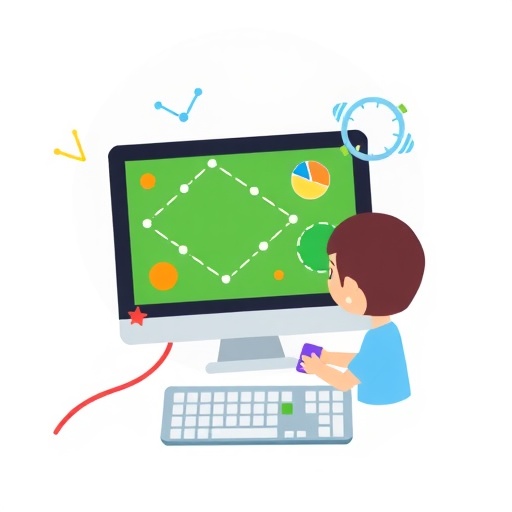In today’s digital age, the early introduction of coding concepts to children has become a pivotal focus for educators and parents alike. Notably, two platforms, Scratch Jr and Tynker Jr, have emerged as leading tools designed specifically to cater to the coding needs of preschool-aged learners. Recent research undertaken by Badr and Elgabry has shed light on the effectiveness of these platforms in teaching fundamental coding skills to kindergarten students. This study emphasizes the importance of engaging with technology from a young age and how structured learning environments can cultivate essential problem-solving skills.
Scratch Jr is an innovative programming environment that allows young children to create their own interactive stories and games. The platform leverages a visual block-coding interface, enabling kids to drag and drop code blocks to animate characters, no prior knowledge of programming required. By employing a user-friendly interface tailored for younger audiences, Scratch Jr instills foundational coding principles through play. This gamification of education not only captivates young minds but also fosters creativity and logical thinking skills that can be beneficial later in life.
On the other hand, Tynker Jr offers a similar, yet distinct, approach to teaching coding to children. The platform features a wide array of interactive stories and games aimed at enhancing programming skills through engaging challenges. Much like Scratch Jr, Tynker Jr utilizes a visual coding language; however, its curriculum is structured around specific educational standards, making it a valuable resource for educators. The platform emphasizes step-by-step progression, ensuring that children build their skills incrementally, thus providing a solid foundation in programming logic.
In their study, Badr and Elgabry meticulously evaluated both platforms through a series of experimental designs involving kindergarten classrooms. The researchers aimed to comprehend not just the effectiveness of Scratch Jr and Tynker Jr in teaching coding skills but also how each platform resonated with young learners. Observations were made on student engagement, comprehension of coding concepts, and the overall educational experience, providing a comprehensive overview of each platform’s strengths and limitations.
The findings revealed that both Scratch Jr and Tynker Jr significantly enhanced children’s understanding of basic coding concepts. However, distinct differences in engagement levels and learning outcomes were noted across the two platforms. Scratch Jr, with its more open-ended approach, allowed children to explore coding freely, thus promoting a sense of ownership and creativity in their projects. This adaptability proved to captivate the attention of young learners, encouraging them to experiment and iterate on their creations without fear of failure.
Conversely, Tynker Jr’s structured approach offered a clear path for learning, with progressively challenging tasks that built upon previous concepts. This gradual progression aided in reinforcing children’s understanding of coding logic, although some students noted that the constraints placed on creativity were limiting. Nevertheless, the empirical data gathered during the study demonstrated that both platforms effectively contributed to the development of coding skills among kindergarteners, albeit through different methodologies.
One crucial component of the research was the observation of social interactions among students while using these platforms. Both Scratch Jr and Tynker Jr were found to encourage collaborative learning, as children often worked together to solve challenges and assist each other in navigating the coding environments. This social dimension not only enhanced their learning experience but also developed critical interpersonal skills, essential for teamwork and communication.
Moreover, the study highlighted the role of teachers in facilitating these learning experiences. Educators became vital in guiding children as they navigated the coding platforms, providing necessary scaffolding and guidance to maximize the educational benefits. Professional development for teachers in utilizing these platforms effectively became evident as an essential factor in the success of coding programs in kindergarten classrooms.
As the education landscape continues to evolve, so too does the need for incorporating technology in early childhood education. The results of Badr and Elgabry’s study advocate for the integration of coding platforms like Scratch Jr and Tynker Jr into early childhood curricula as a means of promoting STEM education from an early age. The implementation of such programs also paves the way for fostering a generation of individuals well-versed in digital literacy, preparing them for an increasingly tech-driven future.
In conclusion, as educators and parents navigate the complexities of teaching coding to young children, the insights gained from this research serve as a guide for harnessing the power of technology in education. Understanding the nuances between different coding platforms helps shape effective teaching strategies tailored for young learners. As evidenced in the study, nurturing children’s innate curiosity through coding not only equips them with vital skills but also instills a lifelong passion for learning and problem-solving.
The implications of these findings extend far beyond the classroom. By fostering a foundation in coding at a young age, children can grow into competent digital citizens, capable of navigating the complexities of the future technological landscape with confidence and creativity. With Scratch Jr and Tynker Jr serving as beacons of innovative educational tools, the future of coding education in early childhood looks incredibly promising.
Subject of Research: Effectiveness of Scratch Jr and Tynker Jr in Teaching Coding Skills
Article Title: Evaluating the Effectiveness of Scratch Jr and Tynker Jr in Teaching Coding Skills for Kindergarten
Article References:
Badr, H.S.M., Elgabry, A.A.H. Evaluating the Effectiveness of Scratch Jr and Tynker Jr in Teaching Coding Skills for Kindergarten.
IJEC (2025). https://doi.org/10.1007/s13158-025-00442-4
Image Credits: AI Generated
DOI: 10.1007/s13158-025-00442-4
Keywords: Coding Skills, Early Childhood Education, Scratch Jr, Tynker Jr, Digital Literacy, Kindergarten, STEM Education.




